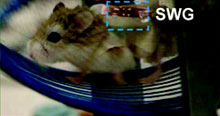Harnessing Hamster Power with a Nanogenerator
Sunlight, wind, and waves aren’t the only sources of renewable energy. For researchers hoping to power nanoscale devices, there’s also muscle power.

Every heartbeat and every fidgety movement that a person makes while sitting at a computer carries with it a small amount of energy that could potentially be scavenged. However, harvesting this biomotion is challenging because so much of it is irregular. Now, for the first time, researchers have demonstrated that a nanogenerator can be driven by irregular, low-energy biomotion, including the tapping of a human finger and a hamster’s erratic running and scratching.
The researchers’ nanogenerator harnesses the piezoelectric effect–the way some crystalline materials produce an electrical potential when placed under mechanical stress. The team, led by Zhong Lin Wang, a professor of materials science and engineering at Georgia Tech, has been making generators using piezoelectric nanowires since 2005. The latest nanogenerator consists of a series of zinc-oxide nanowires mounted on top of a flexible plastic surface. The wires are connected to one another and to an external electrical circuit by metal electrodes. When the plastic bends, the wires bend too, and this motion creates an electrical potential in the wires that drives current through the external circuit.
In a paper published online this week in the journal Nano Letters, Wang’s group describes using the nanogenerator to harvest different kinds of biomechanical energy. The researchers attached the nanogenerator to a person’s index finger and recorded the power output when it tapped on a surface. They also harvested energy from a hamster wearing a small jacket affixed to the device as the rodent ran on an exercise wheel and scratched itself.
Other researchers have developed piezoelectric cantilevers that can also harvest biomechanical energy, but these systems rely on regular mechanical resonance at a specific frequency. Most biomotion–stretching muscles, swinging arms, walking, even the beating of a heart–produces mechanical energy that’s more irregular. Wang says that his group has made the first generator that can truly harvest small, irregular motions.
The energy generated by the device is currently small (about a nanowatt), but Wang says that this is still an important step along the road to developing useful power sources for nanoscale devices. Exquisitely sensitive nanoscale sensors require very little power–about a microwatt–to do things like detect pathogens or cancer proteins. But part of what’s holding back their development is the size and lifetime of existing power supplies. Implantable nanosensors need a power source that is both nanosized and long-lasting, eliminating the need for it to be surgically removed and replaced.
Wang’s group hasn’t made an implantable version of the nanogenerator yet, but Wang says that, in theory, it should be possible. The nanogenerators might, for instance, be encased in biocompatible polymers and implanted in muscle tissue.
The researchers are working on increasing the power of the device by adding more piezoelectric wires arranged in series. In addition to powering nanoscale devices, the piezoelectric generators could perhaps be coupled to larger devices. Over the next five to ten years, Wang hopes to significantly boost the power output of the generator so that it could be woven into the fabric of a human-sized jacket and harvest enough energy to charge batteries for portable electronic devices.
Keep Reading
Most Popular
Large language models can do jaw-dropping things. But nobody knows exactly why.
And that's a problem. Figuring it out is one of the biggest scientific puzzles of our time and a crucial step towards controlling more powerful future models.
The problem with plug-in hybrids? Their drivers.
Plug-in hybrids are often sold as a transition to EVs, but new data from Europe shows we’re still underestimating the emissions they produce.
Google DeepMind’s new generative model makes Super Mario–like games from scratch
Genie learns how to control games by watching hours and hours of video. It could help train next-gen robots too.
How scientists traced a mysterious covid case back to six toilets
When wastewater surveillance turns into a hunt for a single infected individual, the ethics get tricky.
Stay connected
Get the latest updates from
MIT Technology Review
Discover special offers, top stories, upcoming events, and more.